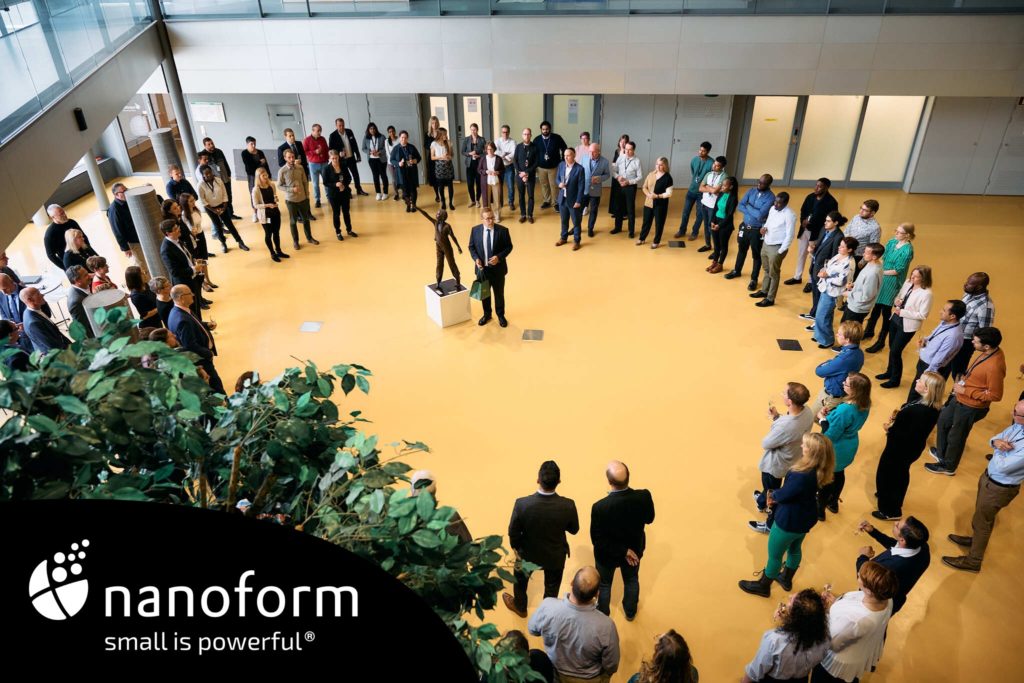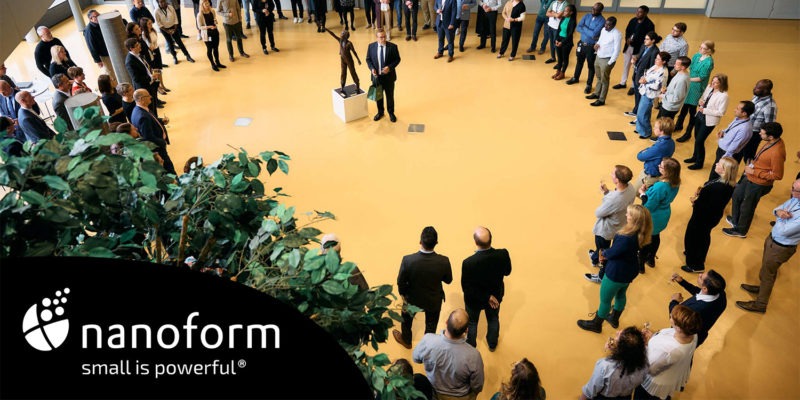Balancing Innovation and Industrialization in a Growth Company—Reflecting on 2022 with Nanoform’s Chief Commercial Officer Christian Jones
It is one thing to launch a company on the basis of game-changing innovation and attract initial interest and funding, but quite another to grow it into an enduring success. We sat down with Christian Jones, Chief Commercial Officer, Nanoform, a nanoparticle medicine enabling company, to delve into key trends and developments in 2022 thus far and discuss how Nanoform has maintained the pace of innovation since its inception.
Q: What new trends within the industry are you most excited about?
Jones (Nanoform): I would say four things—the first being the openness to innovation and technology as demonstrated by COVID-19 vaccine development. It was seen that innovations, which previously may have been perceived as not commercially viable, can in fact be utilized to great effect if Pharma adopts a less conservative approach. This realization supports opportunities where technology can add extra value to pharma products. At Nanoform, we are creating more opportunities for our pharma partners using novel technologies, whether it be in the particle-engineering space or drug formulation.
Another trend I’ve noticed is the rising importance of sustainability in drug manufacture. Currently, a significant portion of large pharma’s carbon footprint rests with partners who are manufacturing drug products. Therefore, manufacturing partners that support the industry must innovate to create a more carbon-neutral environment for pharma manufacturing. I think that the importance of sustainability will further increase as we progress into 2023 and beyond.
Additionally, in light of ongoing geopolitical issues, we’ve seen a push toward increasingly localized and predominantly Western-based supply chains. This has, in turn, led to partners preferring to collaborate with other local companies for development and manufacture, thereby leading to a reduced carbon footprint from a logistics perspective. Supply-chain risk is a major consideration when deciding how and where products should be manufactured. In light of this, we have strived to ensure that Nanoform is in an outstanding position to provide development and GMP manufacturing offerings in Europe to support both European and US partners. In the future, we will have a facility in the US. This will be beneficial for our US partners, and those European partners who wish to place their products in the US.
Finally, I would note that patient-centricity has become even more important and is a topic close to Nanoform’s heart. We discuss it with our partners at every opportunity and believe that it is a necessity to develop a patient-centric formulation, rather than an afterthought. The partners that really focus on the patient-centricity of a formulation are likely to succeed in this increasingly competitive market by developing better medicines for patients. At Nanoform’s headquarters in Helsinki, we recently unveiled a statue of a young patient, CESSilia (see photo below). She reminds us that we’re ultimately here for one reason: to touch the lives of one billion patients by innovating within the pharma industry.

Q: What have been the standout moments for Nanoform this year?
Jones (Nanoform): The data from our collaboration with TargTex, a European biotech company, is without question one of the standout achievements for 2022. We worked with TargTex to support the development of a therapy for glioblastoma—the most common malignant brain tumor. Ultimately, by applying our CESS® nanoparticle engineering technology, we enabled a fivefold increase in drug loading compared to nanomilling, the less effective alternative. In vivo data from the hydrogel formulation showed tumor eradication in rodents at only 44% of the maximum drug-loading dose. The final formulation was GMP-scalable and has led to further opportunities to explore how our technology can be used for other localized oncology treatments.
We also completed a technology evaluation with AstraZeneca to assess the additional value our CESS® technology could deliver across the pharmaceutical value chain. The outcome was positive, and AstraZeneca is now in the identification and implementation stage for clinical programs for Nanoform’s CESS® technology.
The progression of our GMP manufacturing expansion was an important part of 2022 for us. We tripled our GMP manufacturing capacity, grew our organization further, and raised money for expansion into the US market. In response to demand, we are adapting to the growing pipeline of customers interested in our services, both in the lab and in commercial manufacture. We want to be able to handle as many types of molecules as possible. So, in line with a growing interest in oncology treatments and high-potency active pharmaceutical ingredients (HPAPIs), we put in place two new GMP suites capable of handling HPAPIs at 30 nanograms per cubic meter at the OEL level, which will allow us to nanoform nearly all small-molecule drugs to GMP. This is a globally unique offering within our industry. The ability to handle nanoparticle HPAPIs at the containment level that we can and in the particle-size range that we can sets Nanoform apart from all others.
During the first six months of 2023, we expect to have had an inspection by the Finnish Medicines Agency (FIMEA) (which is aligned with the European Medicines Agency) to approve both new GMP suites for GMP manufacture, and our expansion will be fully operational.
Q: How have you maintained the pace of innovation since Nanoform’s IPO, and specifically this year?
Jones (Nanoform): Nanoform was formed initially to commercialize our game-changing CESS® technology, a bottom-up nanoparticle engineering approach that dissolves small-molecule API powders in supercritical carbon dioxide and recrystallizes them under controlled temperature and pressure to produce nanoparticles that are tunable in size, shape, and polymorphic form. Since Nanoform’s inception and throughout 2022, we have continued to optimize our CESS® technology and we have increased throughput by a factor of more than 100x.
In 2022, we released the next iteration of our sparse-data AI-based platform in the form of STARMAP® Online, which allows our partners to virtually screen their drug candidates for probability of success with CESS®.
We try to stay ahead of our customer’s needs, which led us to expand our offerings. We released our biologics technology in late 2020 to explore where small can be powerful in biologic drug-delivery applications. Most biologic drugs are given intravenously; however, with Nanoform’s nanoparticle versions, we are opening new possibilities for alternative routes of administration and improvements in existing formulations. This year we are building a pilot line for tech transfer to GMP for the biologics technology as we see a real advantage for handling molecules in a wide range of molecular sizes and have so far demonstrated the technology up to 150 kDa.
In combination with our technology offerings and GMP manufacturing expansion, we also believe that size is a valuable ingredient in formulations, and we now offer unique formulation services for our partner, as our nanoscale particle sizes can enhance solubility and bioavailability and enable unique drug-delivery applications. Not only can our nanoparticles offer advantages to formulations, they can also enable unique IP positions in this space to further enhance and protect our partners valuable assets.
Q: What inspired Nanoform to produce their sustainability eBook setting out Nanoform’s sustainability credentials?
Jones (Nanoform): At Nanoform, we are committed to ensuring our services are both patient-centric and planet-centric. Since Nanoform was founded, sustainability and green technologies have been at the forefront. However, as the values become more important to our partners, we see the need to produce a comprehensive resource for our sustainability credentials. Our technology is free from environmentally unfriendly organic solvents—unlike alternative technologies, such as spray drying. This is a huge advantage for our pharmaceutical manufacturing partners who are looking to reduce their carbon footprint.
Additionally, we may be able to reduce drug dosages for patients by reducing the particle size into the nano-range. This could have an important knock-on effect of conserving resources in drug-product manufacturing due to less API being produced.
Our technology is also sustainable from the perspective of reusing by-products from other industrial processes. We use clinical-grade carbon dioxide, collected and reused from a waste product from road salt manufacture in Finland, for use in our CESS® process. Going forward, we will be looking at approaches to capture carbon dioxide that has been used in our process and further recycle it downstream.
At Nanoform, we pride ourselves on not just looking at our own footprint but being highly focused on improving the footprint of our manufacturing partners as well. We understand their products and the way they are manufactured. We try to identify ways that their products and processes can be optimized to improve their green credentials, and potentially this could lead to their drug being marketed favorably from a sustainability perspective.
Internally, we have a company-wide operational excellence program for manufacturing that is Lean Six Sigma based. We have a training scheme for staff to improve all aspects of our processes and business with regards to sustainability.
Q: You launched STARMAP® Online in 2022. How is AI shaping drug discovery, development, and manufacture?
Jones (Nanoform): Earlier this year, we launched STARMAP® Online, an AI platform which effectively acts as a digital twin of our CESS® technology. We have discussions ongoing with many partners about the different applications of this offering. Some want it as a desktop application, so they can screen molecules in the early stages of drug discovery, and we have other partners who are eager to use STARMAP® to revisit their existing libraries of previously undruggable molecules. And then we have some that are looking at lifecycle extension, and others that are looking to use it in the 505(b)(2) space that want to understand the possible options for creating more patient-centric drugs in this area—understanding that a nanoparticle version may differentiate the formulation. STARMAP® also integrates with our sustainability goals, as fewer in-lab experiments are needed, so fewer reagents are used and therefore less waste is generated.
Q: With 2023 on the horizon, what are you aiming to achieve in the coming year, and how does this build upon what you have already achieved in 2022?
Jones (Nanoform): While the economic landscape is a cause for concern for some companies, Nanoform has grown substantially during the COVID period. Since I joined in 2018, we’ve increased in size from 18 to 150 employees. We are expanding our client base year by year and that trend is only going to continue. We’ve seen huge amounts of activity across many different conferences that we’ve attended. We are set up well to support our future growth over the next few years without seeking further investment, and we have our eyes set on establishing a facility in the US—stay tuned for more news on that in 2023.
We’ll be progressing to meet our goals and objectives set out to our investors and shareholders within our annual reports, and to meet 2025 goals and targets that we proposed at our IPO—which we are on track to do. 2023 is going to be an exciting year for Nanoform!
Would you like to learn how Nanoform can support your drug-development projects? Get in touch by emailing: commercial@nanoform.com


